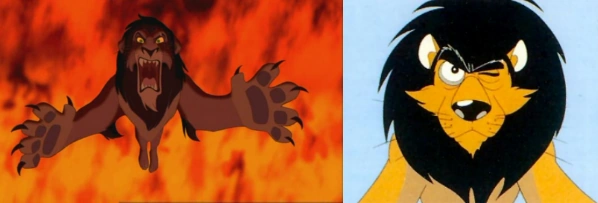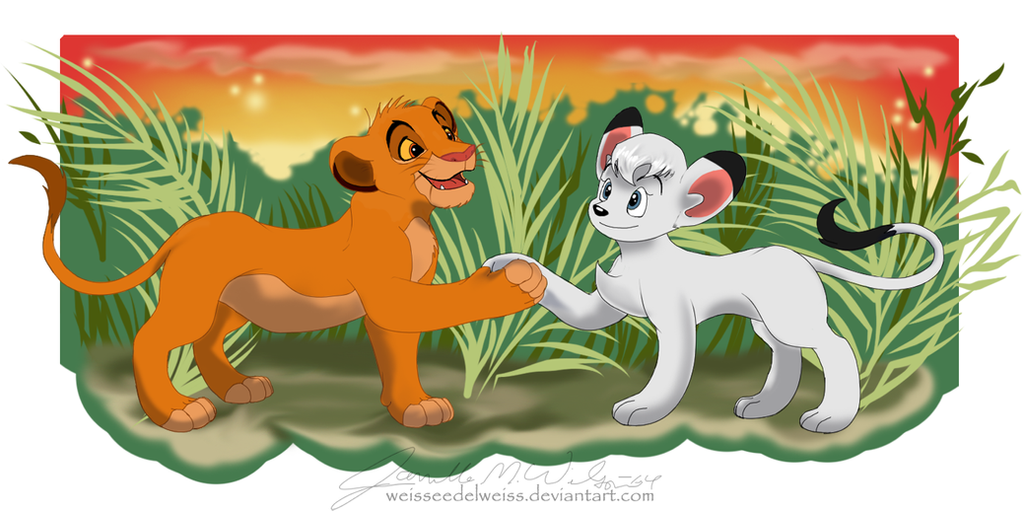Ever since “The Lion King” debuted a little more than 20 years ago, everything the light touches has been its kingdom. The movie is one of the most cherished Disney films of all time, it was turned into the most successful musical ever and its soundtrack was Disney’s most decorated until “Frozen” came along. (Just let it go, “Lion King” fans.)
But despite its massive success, a huge controversy has always dogged the film: “Kimba, the White Lion.”
“I can say there is absolutely no inspiration from ‘Kimba,'” animator Tom Sito told HuffPost Entertainment. Sito’s resume includes classic Disney films such as “Beauty and the Beast,” “Aladdin” and, of course, “The Lion King,” to name a few. “I mean the artists working on the film, if they grew up in the ’60s, they probably saw ‘Kimba.’ I mean, I watched ‘Kimba’ when I was a kid in the ’60s, and I think in the recesses of my memory we’re aware of it, but I don’t think anybody consciously thought, ‘Let’s rip off ‘Kimba.'”
The “Kimba” Controversy
Following animated classics like “The Little Mermaid” (1989), “Beauty and the Beast,” (1991) and “Aladdin” (1992), “The Lion King” was billed as Disney’s first big animated feature that wasn’t a retelling of a fairytale or previous story. And while the film took a lot of inspiration from Shakespeare’s “Hamlet,” its originality was still praised by critics and audiences.
Not everyone was impressed, though.

Image: YouTube/Tezuka
After the movie’s release, many were shocked by its similarities to a Japanese-created American television cartoon series called “Kimba, the White Lion.” That cartoon, about African wildlife, began airing in the 1960s and was based off of a Manga comic called “Jungle Emperor Leo” by animator Osamu Tezuka.
Disney and the filmmakers quickly denied any influence.
The company’s stance was that those involved with the film had no knowledge of “Kimba” or Tezuka. In an interview with the Los Angeles Times, “The Lion King” co-director Rob Minkoff said, “Frankly, I’m not familiar with [the TV series],” in reference to the controversy. He also added that he and co-director Roger Allers first learned about the debate on a trip to Japan to promote the movie.
But as author Madhavi Sunder pointed out, Allers actually worked as an animator in Japan in the 1980s, a place where “Jungle Emperor” was widely seen, and its creator, Tezuka, is known as Japan’s Walt Disney.

Image: Imgur
In a recent interview with Fumettologica, Allers said, “I could certainly understand Kimba’s creators feeling angry if they felt we had stolen ideas from them. If I had been inspired by ‘Kimba’ I would certainly acknowledge my inspiration.”
Minkoff and Allers did not respond to requests for further comment from HuffPost Entertainment.
Disney’s denial of any influence inspired petitions and protests from animators and fans alike who believed “Kimba” should have been acknowledged. Well-known Japanese cartoonist Machiko Satonaka, who says she was told by the company that “Disney has never heard of ‘Jungle Emperor’ or ‘Kimba, the White Lion,'” wrote an open letter to the studio that was signed by hundreds of animation professionals. “The Simpsons” even parodied the controversy in a 1995 episode by having a lion appear in the clouds to say, “You must avenge my death, Kimba … I mean, Simba.”

But did these protesters really have a case? The past can hurt, but you can either run from it or learn from it.
The Similarities

Image: PixGood/Disney/OsamuTezuka
Though Disney seems to hold one firm opinion on the Simba vs. Kimba debate, actor Matthew Broderick — who voiced Simba — admitted he was initially confused about his role. “I thought he meant Kimba, who was a white lion in a cartoon when I was a little kid,” Broderick had said in a 1994 interview about his casting.
And while the projects differ in their storylines — with the Japanese cartoon exploring the relationship between humans and animals — there are some visual similarities between the two.

Image: Imgur
From the epic vision of a lion standing atop Pride Rock to the unforgettable appearance of Mufasa in the clouds, “The Lion King” does appear to mirror “Kimba” at certain points.

Image: YouTube
Many also reference similarities in the characters as proof of a connection. In addition to the main characters having extremely similar names — Kimba and Simba, respectively (Kimba is known as Leo in “Jungle Emperor”) — there is also a sage baboon, bumbling hyenas, a young lioness love-interest, a Zazu-like bird and an evil lion with an eye ailment. His name is Claw.

Image: Ehnamelox/DisneyWiki
The Real Story
In an interview with HuffPost Entertainment, Sito said “Kimba” did not serve as source material for the film. But his comments confirm that at least some people working on the project had seen the cartoons and comics before, which is contrary to the initial reported corporate stance that the filmmakers were unaware of “Kimba” or Tezuka. (In a 1994 interview, Minkoff did not rule out the possibility that Tezuka was discussed in the years prior to his arrival on the project.)

Image: Giphy
Sito says when filmmakers first learned about similarities between the projects, it was already late in the production process, with more than half the film having been completed.
“One of the animators found a Manga comic book of Kimba’s with a setup that kind of looked like Pride Rock, and I remember he was like showing it to us, and I was like, ‘Wow, that is really close to ours, yeah.’ But I think it was never more than an amusing coincidence,” said Sito.
Other filmmakers on the project confirm Sito’s comments. In a 1997, Mark Kausler, who has a story credit on the film, told author Fred Patten that he had watched “Kimba” as a kid, but during the production process the animators were focused on creating a story that was more like “Bambi” set in Africa without the “animals versus man” theme:
Nobody ever mentioned “Kimba,” and if any of us who knew of it thought about it, I guess we figured that since “Kimba” was always about the animals trying to get the humans to accept them as equals, the absence of humans in “The Lion King” made it obviously a different plot.
In regard to “Bambi” serving as a template for “Lion King,” Sito said, “I think we were trying to achieve the same naturalism in the acting as ‘Bambi.’ The animals don’t walk around on two legs, and wear gloves with three lines on them. The art directors were also inspired by the color palate [as the] ‘Bambi’ art director Tyrus Wong. Taking into account the vastly different setting of course, ‘Lion King’ is in African savannah while ‘Bambi’ is set in a North American indigenous forrest.”
Though “The Lion King” wasn’t developed with “Kimba” in mind, the similarities are evident. In his book Watching Anime, Reading Manga: 25 Years of Essays and Reviews, Patten cites an interview with “Lion King” animator Sadao Miyamoto, in which he told Bridge U.S.A. that he was “taken aback” when he first saw storyboards because of their likeness to Tezuka’s work and that there must’ve been at least some influence.

Image: Imgur
Sito explained that wasn’t necessarily the case. “Honestly, I think it’s seriously coincidence,” the animator said. “You know I’m not a spokesman for Disney, but I was there during all the story development and nobody consciously thought [about] that. I think when you do the kind of things that lions do, the grasslands and the kind of environment they’re in, and the type of props they would work with, trees and rocks and the other animals, I think some similarities are inevitable.”
Disney did not respond to requests for comment.
Back in 1994, Takayuki Matsutani, the president of Osamu Tezuka’s production company, Tezuka Productions, agreed with what Sito said today:
Quite a few staff of our company saw a preview of “The Lion King,” discussed this subject and came to the conclusion that you cannot avoid having these similarities as long as you use animals as characters and try to draw images out of them.
Matsutani continued saying that if Tezuka had thought Disney “got a hint” of “Lion King” from his work, he would have been pleased.

Fan art by WeisseEdelweiss
In the end, it all comes full circle.
Even with its similarities to “The Lion King,” Tezuka’s work has clear differences. “Kimba is much more exotic. You know, Kimba gets up on two feet and punches other animals in the mouth, gives them a knuckle sandwich, you know, and our lions don’t really do that,” Sito noted.
In addition to “Kimba” having more fantastical plots and anthropomorphic traits in the characters, the biggest contrast between the two projects is without a doubt the relationship between animals and humans, which stems from the original inspiration for “Kimba”: Walt Disney’s “Bambi.”

Image: Giphy
Tezuka died in 1989, but during his life he didn’t bother hiding his affection for Disney, especially his love for “Bambi,” claiming to have seen the film more than 100 times. The animator actually met Walt Disney during a World’s Fair before he ended up licensing “Bambi” for a Japanese adaptation and credits Disney in his autobiography for some creative influence. In his book, From Goods to a Good Life: Intellectual Property and Global Justice, Sunder points out that Tezuka said his own work on “Jungle Emperor,” aka “Kimba,” was an homage and a critique of the film.
Despite all the controversy surrounding “The Lion King” with regard to “Kimba,” both works have stood the test of time and hold an important place in the hearts of fans. With the news that each simply focuses on similar subject matter and drew varying inspiration Disney’s “Bambi,” it’s easy to see how some similarities, as Sito says, are “almost inevitable.”
In the end, it appears this case may just come down to a little thing called the circle of life.

Image: Tumblr
See more “Kimba” characters in the slideshow:
Main image created by WhiteLionWarrior.








